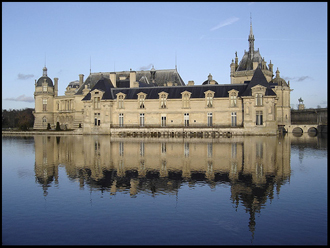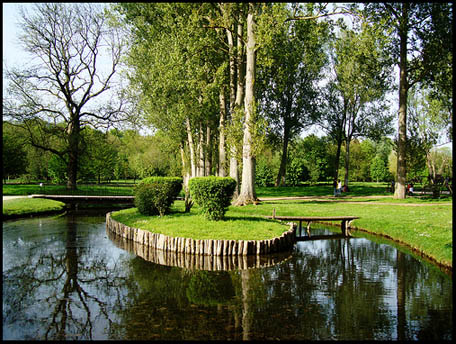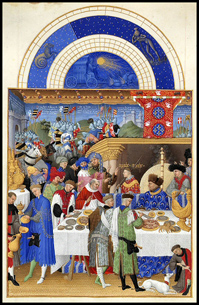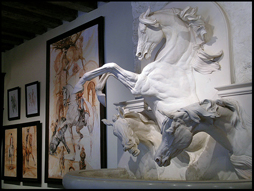
Have you seen the old James Bond movie, A View to a Kill? I actually haven’t. But if you have, then you’ve seen Château Chantilly!
If you haven’t seen the movie like me, don’t worry about it. You can learn all about the château here. Besides, you’d rather see it in person anyway, wouldn’t you?
The Château Chantilly is one of the most picturesque castles in the region. It sits on a artifical lake, and is surrounded by attractive parkland, with the Chantilly forest in the background.
If you’re a lover of decorative arts, you’d better hop on a plane and get to Château Chantilly. Its Musée Condé is stuffed with palace furniture, family portraits, and Sèvres porcelains. It’s a great place for lovers of horses and riding too. The Living Horse Museum and the Chantilly stables are famous!
When to Go
Between April and December. The château is open from March 30 to December 31, from 10:00 am to 6:00 pm.
The grounds are open 10:00 am to 8:00 pm.
The Living Horse Museum is open all year. From March 30 to October 27, it is open from 10:30 am to 6:00 pm. It closes at 5:00 pm on weekends from October 28 until December 31st.
Open daily from March 30 until September 29th. Closed on Tuesdays September 30 through December 31st.
Cost
You can purchase a Pass Domaine to visit the château, the park, and the Living Horse Museum for €18 for adults and €7,50 for children . This is the cheapest way to go if you’re planning on seeing everything Château Chantilly has to offer.
If you have a Paris Museums Pass you can get into Château Chantilly for free.
A visit to just the château and park is €14 for adults and €5,50 for children.
A visit to the park only is €7 for adults and €3 for children.

History of Château Chantilly
- Château Chantilly was originally built around 1560 by Jean Bullant, for a member of the Montmorency family.
- In the mid-17th century, the Condé family took over ownership of the château, and had lakes, canals, waterfalls, ponds, and a maze added to the grounds.
- The château became a popular venue for festivals and gatherings. Famous visitors include Jean de La Fontaine and Molière.
- As an opulent royal residence, much of the château was destroyed during the French Revolution. What remained was used as a prison
- The château was later rebuilt in the 19th century. It was restored to the French Renaissance style, complete with gables and towers. Chantilly’s receptions and hunting parties were crowded by 19th century high society.
- The château’s most recent owner was duc d’Aumale. In 1886, he gave the château and surrounding park to the Institut de France, along with the art collection and library.
What to See
- The architecture
- Musée Condé
- The Large and Small Apartments
- The stables and Living Horse Museum
- The park and gardens
Château Chantilly has really interesting architecture, since it was built and rebuilt in two different time periods. It features an appealing mix of architectured dating from the 14th to 19th centuries.
 The Musée Condé has a magnificent art collection. The art and furnishings date from the Italian and French Renaissances to the 19th century, and the musuem includes works by Memling, Van Dyck, Botticelli, Poussin, Watteau, Ingres, Delacroix, Corot, Fra Angelico, Rubens, Vernet, and more.
The Musée Condé has a magnificent art collection. The art and furnishings date from the Italian and French Renaissances to the 19th century, and the musuem includes works by Memling, Van Dyck, Botticelli, Poussin, Watteau, Ingres, Delacroix, Corot, Fra Angelico, Rubens, Vernet, and more.
The musuem’s collection of historical paintings is the second largest in France, just behind the Louvre. Inside, you can see Raphael’s Virgin of the House of Orleans and The Three Graces, as well as an entertaining gallery of 16th century portraits by both Jean and Francois Clouet.
A series of 40 miniatures represent the leading French painter of the 15th century, Jean Fouquet. Also on display, in the jewel collection, is a replica of the rose diamond that got worldwide attention when it was stolen in 1926.
One of the most precious Musée Condé acquisitions is Les Très Riches Heures du Duc de Berry, a 15th century illuminated manuscript by the Limbourg brothers illustrating the months of the year. Don’t miss it!
In the Large Apartments you can tour the Prince’s Bedchamber, the Music Room, and the Great Condé Victory Gallery.
The Small Apartments of the Duke and Duchess of Aumale feature lots of lavish furnishings. They were decorated in the 19th century with wood panels, gorgeous furniture, brocade drapes, and many family portraits.
You can also see the Small Monkey Gallery, which was painted in the 18th century. It is covered in decorative panels with monkey motifs. Check it out!
Since Chantilly is famous for its horseracing, the stables are usually of great interest. Les Grandes Ecuries are an equestrian palace designed by Jean Aubert in 1719, and were built for Louis-Henri, the duke of Bourbon. Legend has it that he believed he would be reincarnated as a horse after his death.
The stables feature 18th century French architecture, and were constructed to house 240 horses, with adjoining kennels to accommodate 500 dogs.

Today they contain the Musée Vivant du Cheval (Living Horse Museum). It was created by Yves Bienaimé in 1982, and is an internationally renowned museum. It is considered the biggest and most beautiful of its kind.
Here, you can see horses of all different breeds, equestrian exhibits, works of art pertaining to horses, and riding demonstrations.
The park is a great place for an afternoon stroll. Spanning 285-acres, there are many attractions to keep you entertained, including the Grand Canal, the waterfall, the Chinese garden, the Maison de Sylvie and Le Notre’s 17th century French garden.
There is also a children’s play area, the Enghien Castle, a kangaroo enclosure, and the Hamlet built in 1774 for the Prince of Condé.
Be sure to see the romantic English Garden, complete with an Island of Love, Swan Lake, Temple of Venus, and a Beauvais waterfall.
In the spring and summer, you can sail the canals and lakes in electric boats. You can also take a ride on the litte train touring the grounds, or take trip in a horse drawn carriage.